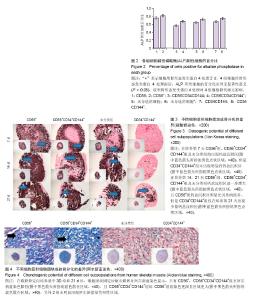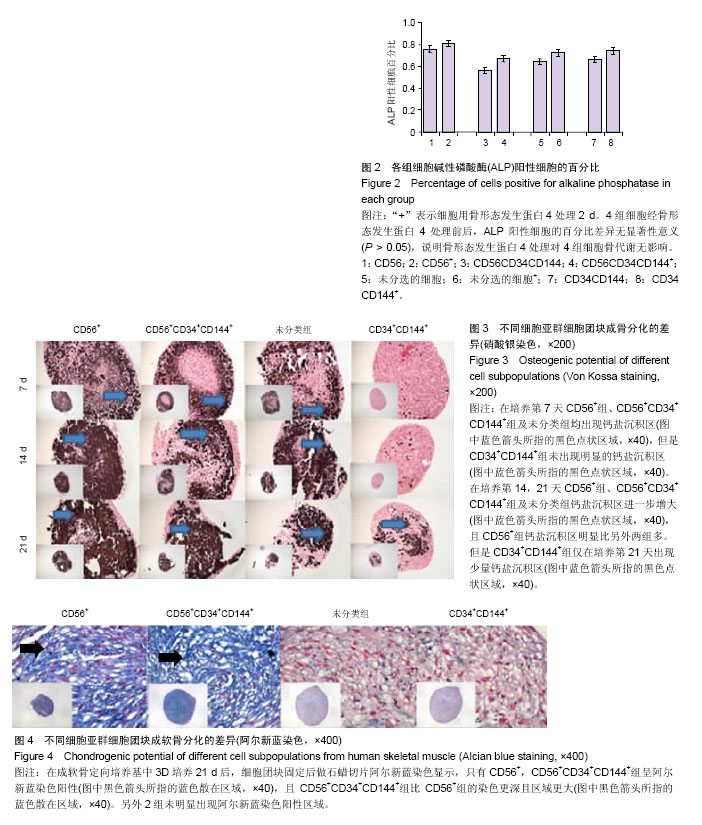Chinese Journal of Tissue Engineering Research ›› 2017, Vol. 21 ›› Issue (13): 2108-2113.doi: 10.3969/j.issn.2095-4344.2017.13.023
Previous Articles Next Articles
Multi-directional differentiation potential of subpopulations of mesenchymal stem cells isolated from human skeletal muscle expressing different myogenic and endothelial markers
Zhao Ya-guang, Li Yi, Song Zhuo-yue, Li Guang-heng
- Department of Orthopedics, the First Affiliated Hospital of Zhengzhou University, Zhengzhou 450000, Henan Province, China
-
Revised:2017-03-13Online:2017-05-08Published:2017-06-09 -
Contact:Li Guang-heng, M.D., Professor, Doctoral supervisor, Department of Orthopedics, the First Affiliated Hospital of Zhengzhou University, Zhengzhou 450000, Henan Province, China -
About author:Zhao Ya-guang, Studying for master’s degree, Department of Orthopedics, the First Affiliated Hospital of Zhengzhou University, Zhengzhou 450000, Henan Province, China -
Supported by:the National Natural Science Foundation of China, No. 81472136
CLC Number:
Cite this article
Zhao Ya-guang, Li Yi, Song Zhuo-yue, Li Guang-heng. Multi-directional differentiation potential of subpopulations of mesenchymal stem cells isolated from human skeletal muscle expressing different myogenic and endothelial markers[J]. Chinese Journal of Tissue Engineering Research, 2017, 21(13): 2108-2113.
share this article

2.1 碱性磷酸酶染色单层细胞骨代谢能力分析 4组贴壁细胞在培养2 d后用碱性磷酸酶染色显示,该4种细胞亚群成骨代谢差异无显著性意义(P > 0.05),如图2。实验可以预知,在体外单层贴壁培养条件下,该4种细胞未表现出特异性的成骨能力。 2.2 3D培养及硝酸银染色成骨分析 3D细胞培养是模拟体内微环境的细胞生存方式。实验将BMP4加入成骨定向培养基中,培养出的细胞团块,呈现出成骨分化能力。 如图3所示,应用硝酸银染色,以CD56+为标记的肌源性细胞,以CD56+CD34+CD144+为标记的肌源性-内皮源性共表达细胞及未分类组呈钙化染色阳性表现。其中以CD56+ CD34+CD144+为标记的肌源性-内皮源性共表达细胞成软骨能力最强。以CD34+CD144+为标记的内皮源性细胞组表现出较弱的钙化潜能(7,14 d),但在21 d观察到了钙化。 2.3 3D培养及阿尔新蓝染色成软骨能力分析 实验将BMP4+转化生长因子β3加入成软骨基础培养基中培养 21 d后,细胞团块表现出成软骨分化差异。 图4所示,运用阿尔新蓝染色特异性标记软骨细胞外基质,只有以CD56+为标记的肌源性细胞,以CD56+CD34+CD144+为标记的肌源性-内皮源性共表达细胞组呈阿尔新蓝染色阳性,其他2组为阴性。因此,实验可以认为肌源性细胞、肌源性-内皮源性细胞与内皮源性细胞及未分选组相比,具有显著的成软骨能力。"

| [1] Li G, Peng H, Corsi K, et al. Differential effect of BMP4 on NIH/3T3 and C2C12 cells: implications for endochondral bone formation. J Bone Miner Res. 2005;20(9):1611-1123. [2] Li G, Zheng B, Meszaros LB, et al. Identification and characterization of chondrogenic progenitor cells in the fascia of postnatal skeletal muscle. J Mol Cell Biol. 2011;3(6):369-377. [3] Afizah H, Hui JH. Mesenchymal stem cell therapy for osteoarthritis. Clin Transl Med. 2016;7(3):177-182. [4] Stem cells may be coming therapy for bone and joint injuries. Post-traumatic arthritis (PTA), a form of osteoarthritis, may no longer be the norm following joint injury. Duke Med Health News. 2013;19(12):6. [5] Ackerman IN, Osborne RH. Obesity and increased burden of hip and knee joint disease in Australia: results from a national survey. BMC Musculoskeletal Disorders. 2012;13:254. [6] Barry F, Murphy M. Mesenchymal stem cells in joint disease and repair. Nat Rev Rheumatol. 2013;9(10):584-594.[7] Grassel S, Lorenz J. Tissue-engineering strategies to repair chondral and osteochondral tissue in osteoarthritis: use of mesenchymal stem cells. Cur Rheumatol Rep. 2014;16(10): 452. [8] Tuan RS, Boland G, Tuli R. Adult mesenchymal stem cells and cell-based tissue engineering. Arthritis Res Ther. 2003; 5(1):32-45. [9] Wang Y, Yuan M, Guo QY, et al. Mesenchymal stem cells for treating articular cartilage defects and osteoarthritis. Cell Transplantation. 2015;24(9):1661-1678. [10] Bashir J, Sherman A, Lee H, et al. Mesenchymal stem cell therapies in the treatment of musculoskeletal diseases. PM R. 2014;6(1):61-69. [11] Burke J, Hunter M, Kolhe R, et al. Therapeutic potential of mesenchymal stem cell based therapy for osteoarthritis. 2016;5(1):27. [12] Caldwell KL, Wang J. Cell-based articular cartilage repair: the link between development and regeneration. Osteoarthritis and cartilage. 2015;23(3):351-362. [13] Crisan M, Yap S, Casteilla L, et al. A perivascular origin for mesenchymal stem cells in multiple human organs. Cell stem cell. 2008;3(3):301-313. [14] Kim YS, Choi YJ, Koh YG. Mesenchymal stem cell implantation in knee osteoarthritis: an assessment of the factors influencing clinical outcomes. Am J Sports Med. 2015; 43(9):2293-2301. [15] Richardson SM, Kalamegam G, Pushparaj PN, et al. Mesenchymal stem cells in regenerative medicine: Focus on articular cartilage and intervertebral disc regeneration. Methods (San Diego, Calif). 2016;99:69-80. [16] Desiderio V, Tirino V, Papaccio G, et al. Bone defects: molecular and cellular therapeutic targets. Int J Biochem Cell Biol. 2014;51:75-78. [17] Elkhenany H, Amelse L, Caldwell M, et al. Impact of the source and serial passaging of goat mesenchymal stem cells on osteogenic differentiation potential: implications for bone tissue engineering. J Animal Sci Biotechnol. 2016;7:16. [18] Zheng B, Cao B, Crisan M, et al. Prospective identification of myogenic endothelial cells in human skeletal muscle. Nat Biotechnol. 2007;25(9):1025-1034. [19] Zhang S, Yap AU, Toh WS. Stem Cells for Temporomandibular Joint Repair and Regeneration. Stem Cell Rev. 2015;11(5):728-742. [20] Redman SN, Oldfield SF, Archer CW. Current strategies for articular cartilage repair. Eur Cells Mater. 2005;9:23-32.[21] Li Z, Kupcsik L, Yao SJ, et al. Mechanical load modulates chondrogenesis of human mesenchymal stem cells through the TGF-beta pathway. J Cell Mol Med. 2010;14(6a): 1338-1346. [22] Gharaibeh B, Lu A, Tebbets J, et al. Isolation of a slowly adhering cell fraction containing stem cells from murine skeletal muscle by the preplate technique. Nat Protocols. 2008;3(9):1501-1509. [23] Jeong J, Shin K, Lee SB, et al. Patient-tailored application for Duchene muscular dystrophy on mdx mice based induced mesenchymal stem cells. Exp Mol Pathol. 2014;97(2): 253-258. [24] Steinert AF, Proffen B, Kunz M, et al. Hypertrophy is induced during the in vitro chondrogenic differentiation of human mesenchymal stem cells by bone morphogenetic protein-2 and bone morphogenetic protein-4 gene transfer. Arthritis Res Ther. 2009;11(5):R148. [25] Camilleri ET, Gustafson MP, Dudakovic A, et al. Identification and validation of multiple cell surface markers of clinical-grade adipose-derived mesenchymal stromal cells as novel release criteria for good manufacturing practice-compliant production. Stem Cell Res Ther. 2016;7(1): 107. [26] Mardones R, Jofre CM, Minguell JJ. Cell therapy and tissue engineering approaches for cartilage repair and/or regeneration. Int J Stem Cells. 2015;8(1):48-53. [27] Molligan J, Mitchell R, Schon L, et al. Influence of bone and muscle injuries on the osteogenic potential of muscle progenitors: contribution of tissue environment to heterotopic ossification. Stem Cells Transl Med. 2016;5(6):745-753. [28] Wyles CC, Houdek MT, Behfar A, et al. Mesenchymal stem cell therapy for osteoarthritis: current perspectives. Stem Cells Cloning. 2015;8:117-124. [29] Savkovic V, Li H, Seon JK, et al. Mesenchymal stem cells in cartilage regeneration. Cur Stem Cell Res Ther. 2014;9(6): 469-488. [30] Pers YM, Ruiz M, Noel D, et al. Mesenchymal stem cells for the management of inflammation in osteoarthritis: state of the art and perspectives. Osteoarthritis Cartilage. 2015;23(11): 2027-2035. [31] 蔡明轩,王美辰,徐治成,等.神经细胞分泌因子促进骨骼肌细胞生长[J].中国组织工程研究,2016,20(42):6324-6329.[32] Lv L, Ge W, Liu Y, et al. Lysine-specific demethylase 1 inhibitor rescues the osteogenic ability of mesenchymal stem cells under osteoporotic conditions by modulating H3K4 methylation. Bone Res. 2016;4:16037.[33] Gu H, Xiong Z, Yin X, et al. Bone regeneration in a rabbit ulna defect model: use of allogeneic adipose-derivedstem cells with low immunogenicity. Cell Tissue Res. 2014;358(2): 453-464. [34] Fu WL, Zhou CY, Yu JK. A new source of mesenchymal stem cells for articular cartilage repair: MSCs derived from mobilized peripheral blood share similar biological characteristics in vitro and chondrogenesis in vivo as MSCs from bone marrow in a rabbit model. Am J Sports Med. 2014; 42(3):592-601.[35] Liu Y, Ming L, Luo H, et al. Integration of a calcined bovine bone and BMSC-sheet 3D scaffold and the promotion of bone regeneration in large defects. Biomaterials. 2013;34(38): 9998-10006.[36] Zhi W, Zhang C, Duan K, et al. A novel porous bioceramics scaffold by accumulating hydroxyapatite spherulites for large bone tissue engineering in vivo. II. Construct large volume of bone grafts. J Biomed Mater Res A. 2014;102(8):2491-501.[37] Zhao Z, Wang Y, Peng J, et al. Improvement in nerve regeneration through a decellularized nerve graft by supplementation with bone marrow stromal cells in fibrin. Cell Transplant. 2014;23(1):97-110. [38] Fu WL, Jia ZQ, Wang WP, et al. Proliferation and apoptosis property of mesenchymal stem cells derived from peripheral blood under the culture conditions of hypoxia and serum deprivation. Chin Med J (Engl). 2011;124(23):3959-3967.[39] Zhang Y, Wang F, Chen J, et al. Bone marrow-derived mesenchymal stem cells versus bone marrow nucleated cells in the treatment of chondral defects. Int Orthop. 2012;36(5): 1079-1086. |
| [1] | Yao Xiaoling, Peng Jiancheng, Xu Yuerong, Yang Zhidong, Zhang Shuncong. Variable-angle zero-notch anterior interbody fusion system in the treatment of cervical spondylotic myelopathy: 30-month follow-up [J]. Chinese Journal of Tissue Engineering Research, 2022, 26(9): 1377-1382. |
| [2] | Wang Jing, Xiong Shan, Cao Jin, Feng Linwei, Wang Xin. Role and mechanism of interleukin-3 in bone metabolism [J]. Chinese Journal of Tissue Engineering Research, 2022, 26(8): 1260-1265. |
| [3] | Xiao Hao, Liu Jing, Zhou Jun. Research progress of pulsed electromagnetic field in the treatment of postmenopausal osteoporosis [J]. Chinese Journal of Tissue Engineering Research, 2022, 26(8): 1266-1271. |
| [4] | An Weizheng, He Xiao, Ren Shuai, Liu Jianyu. Potential of muscle-derived stem cells in peripheral nerve regeneration [J]. Chinese Journal of Tissue Engineering Research, 2022, 26(7): 1130-1136. |
| [5] | Fan Yiming, Liu Fangyu, Zhang Hongyu, Li Shuai, Wang Yansong. Serial questions about endogenous neural stem cell response in the ependymal zone after spinal cord injury [J]. Chinese Journal of Tissue Engineering Research, 2022, 26(7): 1137-1142. |
| [6] | Tian Chuan, Zhu Xiangqing, Yang Zailing, Yan Donghai, Li Ye, Wang Yanying, Yang Yukun, He Jie, Lü Guanke, Cai Xuemin, Shu Liping, He Zhixu, Pan Xinghua. Bone marrow mesenchymal stem cells regulate ovarian aging in macaques [J]. Chinese Journal of Tissue Engineering Research, 2022, 26(7): 985-991. |
| [7] | Hou Jingying, Guo Tianzhu, Yu Menglei, Long Huibao, Wu Hao. Hypoxia preconditioning targets and downregulates miR-195 and promotes bone marrow mesenchymal stem cell survival and pro-angiogenic potential by activating MALAT1 [J]. Chinese Journal of Tissue Engineering Research, 2022, 26(7): 1005-1011. |
| [8] | Zhou Ying, Zhang Huan, Liao Song, Hu Fanqi, Yi Jing, Liu Yubin, Jin Jide. Immunomodulatory effects of deferoxamine and interferon gamma on human dental pulp stem cells [J]. Chinese Journal of Tissue Engineering Research, 2022, 26(7): 1012-1019. |
| [9] | Liang Xuezhen, Yang Xi, Li Jiacheng, Luo Di, Xu Bo, Li Gang. Bushen Huoxue capsule regulates osteogenic and adipogenic differentiation of rat bone marrow mesenchymal stem cells via Hedgehog signaling pathway [J]. Chinese Journal of Tissue Engineering Research, 2022, 26(7): 1020-1026. |
| [10] | Wang Jifang, Bao Zhen, Qiao Yahong. miR-206 regulates EVI1 gene expression and cell biological behavior in stem cells of small cell lung cancer [J]. Chinese Journal of Tissue Engineering Research, 2022, 26(7): 1027-1031. |
| [11] | Liu Feng, Peng Yuhuan, Luo Liangping, Wu Benqing. Plant-derived basic fibroblast growth factor maintains the growth and differentiation of human embryonic stem cells [J]. Chinese Journal of Tissue Engineering Research, 2022, 26(7): 1032-1037. |
| [12] | Wen Dandan, Li Qiang, Shen Caiqi, Ji Zhe, Jin Peisheng. Nocardia rubra cell wall skeleton for extemal use improves the viability of adipogenic mesenchymal stem cells and promotes diabetes wound repair [J]. Chinese Journal of Tissue Engineering Research, 2022, 26(7): 1038-1044. |
| [13] | Zhu Bingbing, Deng Jianghua, Chen Jingjing, Mu Xiaoling. Interleukin-8 receptor enhances the migration and adhesion of umbilical cord mesenchymal stem cells to injured endothelium [J]. Chinese Journal of Tissue Engineering Research, 2022, 26(7): 1045-1050. |
| [14] | Luo Xiaoling, Zhang Li, Yang Maohua, Xu Jie, Xu Xiaomei. Effect of naringenin on osteogenic differentiation of human periodontal ligament stem cells [J]. Chinese Journal of Tissue Engineering Research, 2022, 26(7): 1051-1056. |
| [15] | Wang Xinmin, Liu Fei, Xu Jie, Bai Yuxi, Lü Jian. Core decompression combined with dental pulp stem cells in the treatment of steroid-associated femoral head necrosis in rabbits [J]. Chinese Journal of Tissue Engineering Research, 2022, 26(7): 1074-1079. |
| Viewed | ||||||
|
Full text |
|
|||||
|
Abstract |
|
|||||